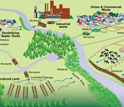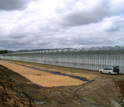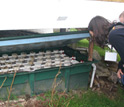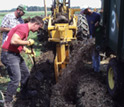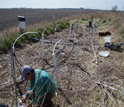News Release 10-206
New Way of Removing Excess Nitrogen from the Environment
Denitrifying bioreactors subject of workshop, special scientific journal issue
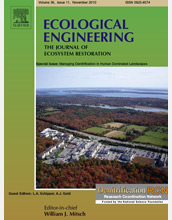
New results on nitrogen in the environment are reported in Ecological Engineering.
November 1, 2010
This material is available primarily for archival purposes. Telephone numbers or other contact information may be out of date; please see current contact information at media contacts.
Excess nitrogen from agricultural and urban lands is contaminating groundwater, streams, lakes and estuaries, where it causes harmful algal blooms and contributes to fish kills.
Cost-effective approaches to removing this nitrogen from croplands and urban stormwater runoff before it reaches sensitive water bodies have been elusive.
But simple and inexpensive technologies are on the horizon. A recent scientific workshop on denitrification brought together ecologists, engineers and policy experts to find answers.
Denitrification is a biological process carried out by soil and aquatic microorganisms, in which forms of reactive nitrogen are converted to unreactive and harmless dinitrogen gas.
Findings from the workshop, held in May, 2009, at the University of Rhode Island, are published in the November, 2010, special issue of the scientific journal Ecological Engineering.
The workshop was sponsored by the National Science Foundation (NSF)'s Denitrification Research Coordination Network (RCN), established to enhance collaboration among researchers investigating denitrification.
"This special issue of Ecological Engineering, with its focus on managing denitrification in human-dominated landscapes, highlights our need to understand Earth's microorganisms and their processes," says Matt Kane, program director in NSF's Division of Environmental Biology, which funded the RCN and the workshop.
"The RCN brought together an international and interdisciplinary group of scientists and engineers to synthesize the knowledge necessary to provide pure water for generations to come."
At the workshop, more than 40 participants combined their expertise to address the goal of using ecological principles in engineering design to control nitrogen pollution.
One workshop goal was to evaluate a new and relatively inexpensive way to treat wastewater and drainage from agricultural lands using "denitrifying bioreactors."
These bioreactors use common waste products, such as wood chips, to provide a food source for naturally occurring microorganisms. The microbes convert dissolved nitrogen into harmless nitrogen gas, which is then released to the atmosphere.
Research results in Ecological Engineering are reported from New Zealand, Canada and several locations in the United States.
All confirm that denitrifying bioreactors may be used in many settings, and operate well in a range of temperatures.
The systems have been successful in the cleanup of domestic effluent from small townships, septic tank systems and wastes from dairy farms, says Louis Schipper of the University of Waikato, New Zealand, author of the lead paper in the journal.
"Denitrifying bioreactors have been integrated into agricultural fields," adds Eric Davidson of The Woods Hole Research Center in Falmouth, Mass., and co-author of the journal's lead paper.
"Underground drainage pipes there remove excess water that contains excess nitrogen. By intercepting some of this drainage water, direct inputs of nitrate to surface water can be reduced."
The largest bioreactor tested, by Schipper and colleagues Stewart Cameron and Soren Warneke at the University of Waikato, is 200 meters long by five meters wide by two meters deep. It treats effluent from greenhouse-grown tomatoes.
Research led by Will Robertson of the University of Waterloo found that bioreactors may operate for more than a decade without replacement of wood chips or substantive maintenance.
Similar longevity was confirmed in research in Iowa by Tom Moorman of the USDA-Agricultural Research Service.
Studies by D.Q. Kellogg and Art Gold of the University of Rhode Island demonstrate that recent advances in geospatial data--such as computer-based maps of geologic and land-use patterns--provide a decision-support tool for local regulatory and planning agencies.
These advances, Kellogg and Gold say, will help reduce nitrate-loading to downstream waters.
A study conducted at the University of California at Davis by Harold Leverenz and reported in the journal showed that plants may be grown on the surface of denitrifying bioreactors, providing biodiversity benefits.
"Research presented in this special issue of Ecological Engineering goes a long way toward applying a scientific understanding of the biological processes of denitrification to the engineering challenges of denitrifying bioreactors," says Davidson.
"The resulting guidelines and principles for denitrifying bioreactor design and operation are an additional option in the land manager's tool box."
-NSF-
-
Excess nitrogen is finding its way through the global environment and into rivers and streams.
Credit and Larger Version -
A denitrifying bioreactor in New Zealand; it treats effluent from greenhouse-grown tomatoes.
Credit and Larger Version -
A up-close view of filters inside a denitrifying bioreactor installed at a Rhode Island home.
Credit and Larger Version -
Denitrifying bioreactors, like one in Iowa, may operate for a decade without maintenance.
Credit and Larger Version -
An Illinois denitrifying bioreactor removes nitrogen from the croplands of the U.S. midwest.
Credit and Larger Version
Media Contacts
Cheryl Dybas, NSF, (703) 292-7734, email: cdybas@nsf.gov
The U.S. National Science Foundation propels the nation forward by advancing fundamental research in all fields of science and engineering. NSF supports research and people by providing facilities, instruments and funding to support their ingenuity and sustain the U.S. as a global leader in research and innovation. With a fiscal year 2023 budget of $9.5 billion, NSF funds reach all 50 states through grants to nearly 2,000 colleges, universities and institutions. Each year, NSF receives more than 40,000 competitive proposals and makes about 11,000 new awards. Those awards include support for cooperative research with industry, Arctic and Antarctic research and operations, and U.S. participation in international scientific efforts.
Connect with us online
NSF website: nsf.gov
NSF News: nsf.gov/news
For News Media: nsf.gov/news/newsroom
Statistics: nsf.gov/statistics/
Awards database: nsf.gov/awardsearch/
Follow us on social
Twitter: twitter.com/NSF
Facebook: facebook.com/US.NSF
Instagram: instagram.com/nsfgov



